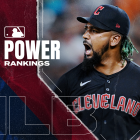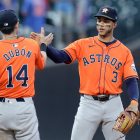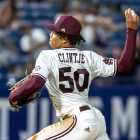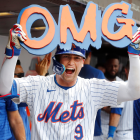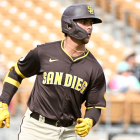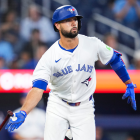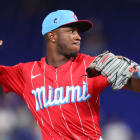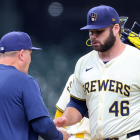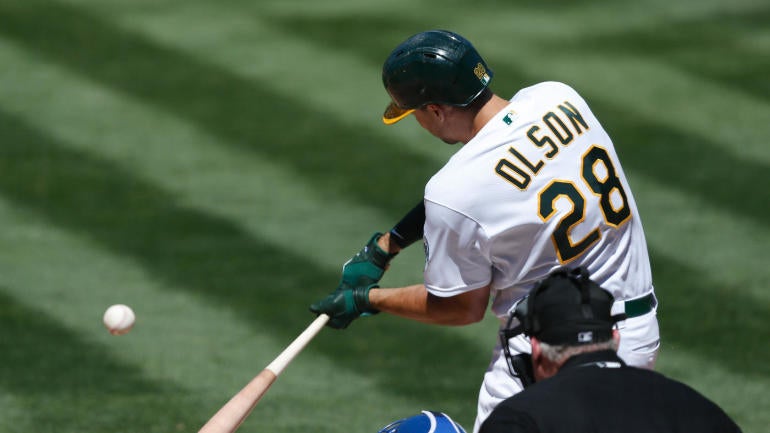
I know it feels like the 2021 MLB season is just getting underway, but we're much closer to the trade deadline (six weeks and two days) than we are Opening Day (10 weeks and six days). That happened fast, huh? The All-Star break is only four weeks away.
Our weekly series examining various trends across the league continues with a look at two hitters who have rebounded from poor 2020 seasons, and a young pitcher who had to scrap a new pitch. Last week we examined Shohei Ohtani's control, Akil Baddoo's plate discipline, and the Cardinals' walk problems.
Olson's improved strikeout rate
A year ago the Athletics won 36 games (in a 60-game season) and their first AL West title since 2013. They did that despite a poor year from first baseman Matt Olson, who slugged 36 home runs with a .267/.351.545 batting line in 2019, but slipped to .195/.310/.424 in 2020. He went from MVP vote-getter to one of the least productive first basemen in the game.
"To put it bluntly, I stunk last year, in my opinion," Olson told reporters, including MLB.com's Martín Gallegos, in spring training. "There were definitely things wrong with the swing that I was going out there with every day. I don't think that represents in any way the caliber of player that I think that I am."
Two months into 2021, Olson has not only bounced back from his poor 2020 season, he's better than ever. The 27-year-old took a .290/.375/.606 batting line and 18 home runs into Tuesday night's game, good for a 175 OPS+. That means that, once adjusted for ballpark and other run-scoring environment factors, Olson has been 75 percent better than an average MLB hitter this year.
The most striking number: 17.0 percent. That is Olson's strikeout rate. Last year he struck out in 31.4 percent of his plate appearances, and even in 2019, he struck out a healthy 25.2 percent of the time. That's not horrible, but it is high. This year Olson is striking out well below the 24.0 percent league average. He's upped his contact considerably.
Among the 199 players with at least 200 plate appearances this year and last, no one has improved their strikeout rate and swing and miss rate more than Olson. Here are the biggest year-to-year changes:
| Strikeout rate | Swing and miss rate |
|---|---|
1. Matt Olson, Athletics: -14.4 percentage points | 1. Matt Olson, Athletics: -3.1 percentage points |
2. Tommy Edman, Cardinals: -9.4 percentage points | |
3. Nick Castellanos, Reds: -8.9 percentage points | 3. Charlie Blackmon, Rockies: -2.4 percentage points |
4. Nelson Cruz, Twins: -8.2 percentage points | 4. Austin Riley, Braves: -2.1 percentage points |
5. Alex Verdugo, Red Sox: -8.1 percentage points |
Olson struck out 77 times in 245 plate appearances last year. This year he's struck out only 44 times in 259 plate appearances. Given his tendency to hit the snot out of the ball -- Olson is an elite exit velocity hitter, both in terms of average exit velocity (93.2 mph) and max exit velocity (115.3 mph) -- all that additional contact has equaled a lot of hits. 23 more than last year, already.
"I just feel like the quality of at-bat that I've been having is a lot better than previous years," Olson recently told reporters, including Matt Kawahara of the San Francisco Chronicle. "I feel that I'm using the whole field better, and I don't feel like I need to force anything to go the other way or have to cheat to get to inside pitches. I just feel like I'm up there competing and hitting the ball where it's pitched. I don't know what the numbers are, but I feel like that's something I'm happy with."
Olson's success can be attributed, at least partly, to something the Athletics call their "little red machine," according to The Athletic's Alex Coffey. The "little red machine" is an undisclosed pitching machine that can apparently be bought at sporting goods stores, and was introduced to Olson (and the rest of the A's) by Tommy La Stella last year. Olson bought one and worked with it over the winter.
Here's what A's assistant hitting coach Eric Martins told Coffey about Olson and the "little red machine."
"The machine has some ride to it," Martins said. "It feels like the ball is rising on you, and you can't make contact if you're working underneath the baseball — if you're not in a good position to hit. So I just think the muscle memory of getting on top of the ball has created some good habits for him and reinforced some other stuff that he's done in the past.
"It's cleaned up his bat path, helped him keep his barrel on the baseball as he gets into the zone, so those are the habits that he creates while using it. You can't be lazy with this thing. You have to be direct to the baseball."
Whatever the reason, Olson has rebounded from a poor 2020 season to become one of the game's most fearsome all-around hitters. He's striking out less, he's hitting for a higher average, and he's among the league leaders in home runs. Olson has been the best player on a first place team, and that usually equals a trip to the All-Star Game in July.
"Look, if anybody was sitting here and said they didn't want to be an All-Star, I think they'd be lying," Olson told Kawahara. There's a lot of baseball left this season ... So I'm focused on us still playing winning baseball and having good at-bats and us keep rolling here as a team."
Benintendi rediscovers power stroke
From 2017-18, Andrew Benintendi was one of the top young outfielders in the game. He authored a .280/.359/.444 batting line with plus defense that made him worth 7.6 WAR in only 299 games those two years, his age 22-23 seasons. Benintendi was instrumental in the Red Sox's run to the 2018 World Series title, and looked like a long-term building block in Boston.
Fast forward to 2021, and Benintendi is now with the Royals, having been dealt to Kansas City in a change of scenery trade over the winter. His production slipping in the second half in 2019, including a .141/.243/.219 batting line that September, and last year he went 4 for 39 (.103) in 14 games before going down with a season-ending rib injury.
The Royals bought low on a talented player and, early on this year, they were getting the late 2019 and 2020 version of Benintendi. His batting line bottomed out at .180/.254/.230 on April 21, and he'd struck out 17 times in 67 plate appearances, or 25.4 percent. That was well above the 16.5 percent strikeout rate he posted from 2017-18.
"I feel like I'm so close. It's so frustrating because it's so close," Benintendi told reporters, including Lynn Worthy of the Kansas City Star, in April. "... Sometimes you just have to slow it down and be like, 'Look we still have 150-something games left. It's going to come eventually.' Then in the meantime, just do anything I can to help the team win."
Since bottoming out on April 21, Benintendi has been a force, hitting .323/.374/.506 with eight homers and a 15.8 percent strikeout rate in 44 games. He's gone deep four times in eight games in June, and has 12 multi-hit games in his last 38 contests after having 12 multi-hit games in his previous 74 games dating back to 2019.
"Benny has just really put on a show for the last month," Royals manager Mike Matheny told Worthy. "It's so good to see because he's not trying to do what he did (on June 1, when he hit his second career grand slam). He's just trying to take what they're giving him, and take good at-bats, find the barrel, use the whole field."
Benintendi's struggles late in 2019 and in 2020 are at least partly attributable to bulking up too much, and trying to hit for power. It was the juiced ball era and Benintendi admitted to wanting in on the action. The added bulk and his propensity to sell out for power led to a big increase in swing and miss rate, and thus a big decline in production overall.
The correlation between Benintendi's slugging percentage and swinging strike rate is pretty obvious:
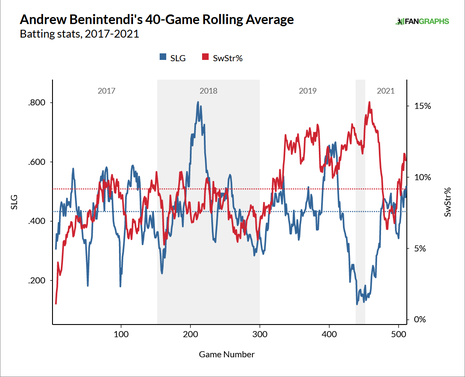
Benintendi didn't overhaul his swing or change his approach this year. He simply went back to what worked in 2017 and 2018, and got away from focusing on power like he did in 2019 and 2020. It's easy to forget he's only 26. Benintendi was a young player who stopped doing what what made him successful, and has since corrected that, and gotten back to being an impact player.
"I feel like I understand the player that I am and what I can do on a consistent day-to-day basis," Benintendi told Worthy recently. "So I'm just going up there trying to hit the ball hard. That's all I can control. Swing at good pitches, control the zone and try to barrel it up. Anything beyond that point is luck, honestly. Hopefully it finds some space."
Alas, Benintendi's rebound season has been put on hold. He was placed on the injured list with a fractured rib earlier this week and will miss some time. It's a tough break for a Royals club trying to hang around the postseason race, and an even tougher break for Benintendi, who has gotten his career back on track as he inches closer to free agent next offseason.
"Not ideal. One of the bright spots we've had on the offense. He's been taking as good of at-bats as anybody," Matheny told reporters, including MLB.com's Anne Rogers, about Benintendi's injury. But it just creates another opportunity for somebody to step up and start getting some production."
Skubal's new old pitch
Very quietly, the Tigers had won 18 of their last 33 games going into Tuesday night. They went 14-13 in May, which was their first winning month since May 2018 (15-14). Detroit's rebuild still has a long way to go (and it still isn't looking so hot), though at least the team is more competitive on the field. They're no longer a total pushover.
Among the reasons the Tigers are showing a little fight these days is rookie lefty Tarik Skubal, who ranked among the game's top pitching prospects this spring. Our R.J. Anderson called Skubal "one of the biggest pop-up successes of the 2019 minor-league season," though his MLB debut didn't go well last year: 5.63 ERA and a .235/.306/.496 opponent's batting line in 32 innings.
Skubal, 24, made Detroit's Opening Day roster this year, and for the first few weeks, it was more of the same. He pitched to a 5.67 ERA with a .255/.355/.604 opponent's batting line in his first seven games (five starts) and 27 innings. At that point, something had to be done, and that something was scrapping the splitter Skubal picked up over the winter. He went back to his changeup.
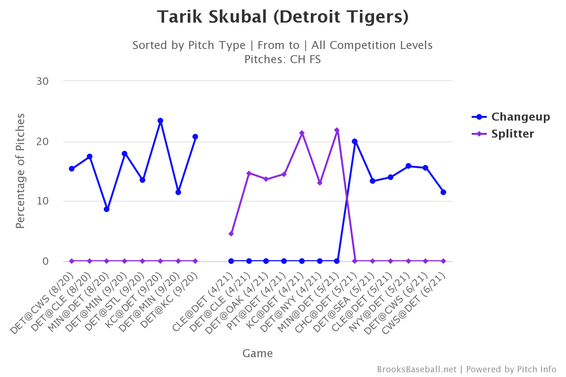
Last month Tigers manager A.J. Hinch jokingly told reporters, including Chris McCosky of the Detroit News, that he and pitching coach Chris Fetter encouraging Skubal to go back to his changeup, though the young southpaw initially resisted. He eventually gave in, and the result is a 3.27 ERA and a .254/.329/.413 opponent's batting line in his last six starts and 33 innings.
"I understand players are always trying to tweak things and find different ways to be better," Hinch told McCosky. "But in this instance, I think he's better suited throwing less splitters and more change-ups because he's primarily a fastball pitcher and that creates hand speed and the changeup works off of that."
Opponents are hitting .182 with a .279 slugging percentage against Skubal's changeup this year, and they're missing with a whopping 48.8 percent of their swings. Against the splitter, opponents were hitting .333 with a .917 slugging percentage, and they missed with only 31.6 percent of their swings. The changeup has been an objectively superior pitch.
Also, because the changeup averages 81.9 mph while the splitter averaged 85.1 mph, Skubal is getting greater velocity separation with his fastball, and his heater is playing up. When he was throwing the splitter, hitters missed with 22.8 percent of their swings against his fastball. With the changeup, it's a 26.9 percent swing and miss rate. The MLB average for fastballs is 23.2 percent.
Skubal picked up the splitter at Driveline Baseball, the famed data-driven pitching lab near Seattle, and adding a pitch is typically a good thing. Especially a splitter, which is arguably the game's most devastating pitch when thrown correctly. It is not for everyone though, and in Skubal's case, he's had more success with his changeup, a pitch he's thrown throughout his career.
"He's trying to feel his way," Hinch told McCosky. "He's very much an open book. He will work on anything and do anything. So he and Fett, and (assistant pitching coach Juan Nieves) and myself, all of us were trying to figure out why his stuff was wavering, what pitches were more effective to use than others and why did he abandon the changeup in the first place."
















